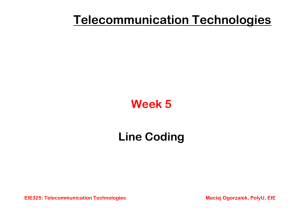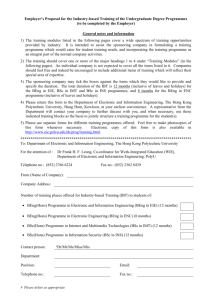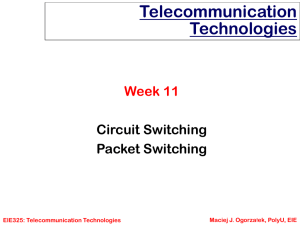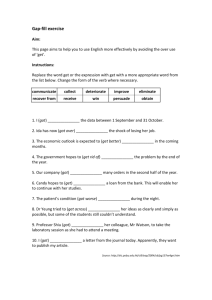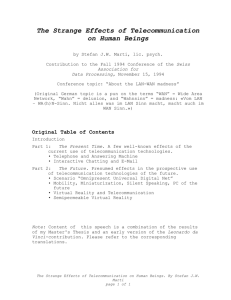Spread Spectrum
advertisement
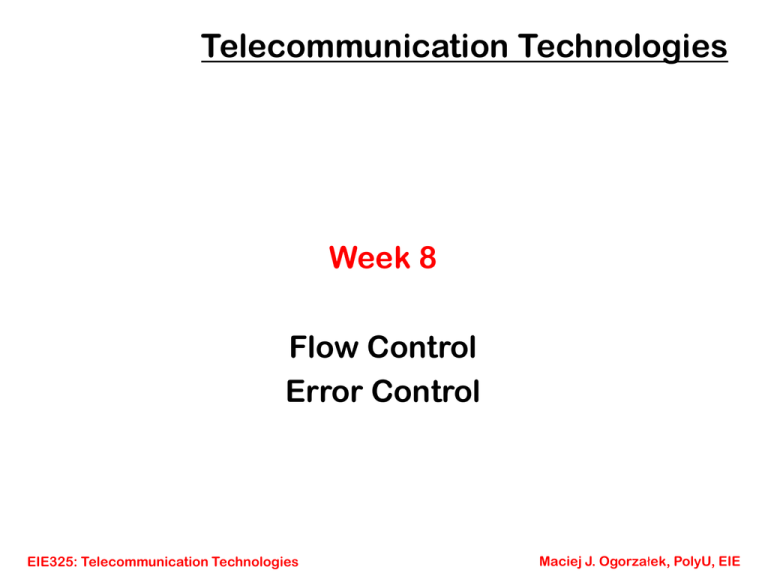
Telecommunication Technologies Week 8 Flow Control Error Control EIE325: Telecommunication Technologies Maciej J. Ogorzałek, PolyU, EIE Where are we? Up until now: Physical Layer Now: Data Link Layer Flow Control Error Control “sending “sendingdata signals overover a data a communications transmission link” link” Later… Synchronisation Multiplexing EIE325: Telecommunication Technologies Maciej Ogorzałek, PolyU, EIE Flow Control Ensuring the sending entity does not overwhelm the receiving entity Preventing buffer overflow Transmission time Time taken to emit all bits into medium Propagation time Time for a bit to traverse the link EIE325: Telecommunication Technologies Maciej Ogorzałek, PolyU, EIE EIE325: Telecommunication Technologies Maciej Ogorzałek, PolyU, EIE Stop and Wait Source transmits frame Destination receives frame and replies with acknowledgement (ACK) Source waits for ACK before sending next frame Destination can stop flow by not send ACK Works well for a few large frames EIE325: Telecommunication Technologies Maciej Ogorzałek, PolyU, EIE Fragmentation Large block of data may be split into small frames Limited buffer size Errors detected sooner (when whole frame received) On error, retransmission of smaller frames is needed Prevents one station occupying medium for long periods Stop and wait becomes inadequate EIE325: Telecommunication Technologies Maciej Ogorzałek, PolyU, EIE EIE325: Telecommunication Technologies Maciej Ogorzałek, PolyU, EIE Question If the data rate is 10 Mbps and transmission is over a distance of 100 m, how long will it take to send 1 Kb in eight 128 byte chunks with stop and wait FC? [assume v = 2×108 ms-1]. EIE325: Telecommunication Technologies Maciej Ogorzałek, PolyU, EIE Stop and Wait Link Utilization EIE325: Telecommunication Technologies Maciej Ogorzałek, PolyU, EIE Sliding Window Flow Control Allow multiple frames to be in transit Receiver has buffer W long Transmitter can send up to W frames without ACK Each frame is numbered ACK includes number of next frame expected Sequence number bounded by size of field (k) Frames are numbered modulo 2k W = 2k-1 EIE325: Telecommunication Technologies Maciej Ogorzałek, PolyU, EIE EIE325: Telecommunication Technologies Maciej Ogorzałek, PolyU, EIE Sliding Window Enhancements Receiver can acknowledge frames without permitting further transmission (Receive Not Ready) Must send a normal acknowledge to resume If duplex, use piggybacking If no data to send, use acknowledgement frame If data but no acknowledgement to send, send last acknowledgement number again, or have ACK valid flag (TCP) EIE325: Telecommunication Technologies Maciej Ogorzałek, PolyU, EIE Error Detection Additional bits added by transmitter for error detection code Parity Value of parity bit is such that character has even (even parity) or odd (odd parity) number of ones Even number of bit errors goes undetected EIE325: Telecommunication Technologies Maciej Ogorzałek, PolyU, EIE Cyclic Redundancy Check For a block of k bits transmitter generates n bit sequence Transmit k+n bits which is exactly divisible by some number Receive divides frame by that number If no remainder, assume no error EIE325: Telecommunication Technologies Maciej Ogorzałek, PolyU, EIE Error Control Detection and correction of errors Lost frames Damaged frames Automatic repeat request Error detection Positive acknowledgment Retransmission after timeout Negative acknowledgement and retransmission EIE325: Telecommunication Technologies Maciej Ogorzałek, PolyU, EIE Automatic Repeat Request (ARQ) Stop and wait Go back N Selective reject (selective retransmission) EIE325: Telecommunication Technologies Maciej Ogorzałek, PolyU, EIE Stop and Wait Source transmits single frame Wait for ACK If received frame damaged, discard it Transmitter has timeout If no ACK within timeout, retransmit If ACK damaged,transmitter will not recognize it Transmitter will retransmit Receive gets two copies of frame Use ACK0 and ACK1 EIE325: Telecommunication Technologies Maciej Ogorzałek, PolyU, EIE Stop and Wait ARQ EIE325: Telecommunication Technologies Maciej Ogorzałek, PolyU, EIE Stop and Wait - Pros and Cons Simple Inefficient EIE325: Telecommunication Technologies Maciej Ogorzałek, PolyU, EIE Go Back N Based on sliding window If no error, ACK as usual with next frame expected Use window to control number of outstanding frames If error, reply with rejection Discard that frame and all future frames until error frame received correctly Transmitter must go back and retransmit that frame and all subsequent frames EIE325: Telecommunication Technologies Maciej Ogorzałek, PolyU, EIE Go Back N - Damaged Frame Receiver detects error in frame i Receiver sends rejection-i (REJ-i) Transmitter gets rejection-i Transmitter retransmits frame i and all subsequent EIE325: Telecommunication Technologies Maciej Ogorzałek, PolyU, EIE Go Back N - Lost Frame (1) Frame i lost and transmitter sends i+1 Receiver gets frame i+1 out of sequence Receiver sends reject i Transmitter goes back to frame i and retransmits EIE325: Telecommunication Technologies Maciej Ogorzałek, PolyU, EIE Go Back N - Lost Frame (2) Frame i lost and no additional frame sent Receiver gets nothing and returns neither acknowledgement nor rejection Transmitter times out and sends acknowledgement frame with P bit set to 1 Receiver interprets this as command which it acknowledges with the number of the next frame it expects (frame i ) Transmitter then retransmits frame i EIE325: Telecommunication Technologies Maciej Ogorzałek, PolyU, EIE Go Back N - Damaged Acknowledgement Receiver gets frame i and send acknowledgement (i+1) which is lost Acknowledgements are cumulative, so next acknowledgement (i+n) may arrive before transmitter times out on frame i If transmitter times out, it sends acknowledgement with P bit set as before This can be repeated a number of times before a reset procedure is initiated EIE325: Telecommunication Technologies Maciej Ogorzałek, PolyU, EIE Go Back N - Damaged Rejection Receiver sends rejection which is lost As for lost frame (2) (Transmitter times out and sends acknowledgement frame with P bit set to 1) EIE325: Telecommunication Technologies Maciej Ogorzałek, PolyU, EIE EIE325: Telecommunication Technologies Maciej Ogorzałek, PolyU, EIE Selective Reject Also called selective retransmission Only rejected frames are retransmitted Subsequent frames are accepted by the receiver and buffered Minimises retransmission Receiver must maintain large enough buffer More complex log at transmitter EIE325: Telecommunication Technologies Maciej Ogorzałek, PolyU, EIE EIE325: Telecommunication Technologies Maciej Ogorzałek, PolyU, EIE Performance Issues What is the line utilisation for various flow control methods? Stop and Wait Sliding Window What is the line utilisation for various ARQ schemes? Stop and Wait Selective Reject Go Back N EIE325: Telecommunication Technologies Which is best ??? Maciej Ogorzałek, PolyU, EIE Stop and Wait Flow Control Assume stations A and B are communicating frames F1,F2,F3,…,Fn Total transmission time T = nTF where TF is the time to transmit one frame and receive an acknowledgement TF = tprop+tframe+tproc+tprop+tack+tproc tprop: propagation delay tframe: time spent transmitting a frame tproc: processing time tack:time spent transmitting an acknowledgement EIE325: Telecommunication Technologies Maciej Ogorzałek, PolyU, EIE Stop and Wait Flow Control TF = tprop+tframe+tproc+tprop+tack+tproc = 2tprop+tframe T = n(2tprop+tframe) T is the total time to transmit, the actual time spent transmitting is only ntframe Line utilisation U = ntframe/T EIE325: Telecommunication Technologies Maciej Ogorzałek, PolyU, EIE Line utilisation Define line utilisation U as the ratio of transmission time to the time taken to transmit data For Stop and Wait define a = tprop/tframe, then U = 1/(1+2a) EIE325: Telecommunication Technologies Maciej Ogorzałek, PolyU, EIE The parameter a We have defined a = tprop/tframe Alternatively, define V: propagation speed (ms-1) d: transmission distance (m) R: data rate (bps) L: frame size (bits) EIE325: Telecommunication Technologies Maciej Ogorzałek, PolyU, EIE Spread Spectrum Analog or digital data Analog signal Objective: Spread data over wide bandwidth Makes jamming and interception harder Frequency hoping Signal broadcast over seemingly random series of frequencies Direct Sequence Each bit is represented by multiple bits in transmitted signal Chipping code EIE325: Telecommunication Technologies Maciej Ogorzałek, PolyU, EIE General model for SS EIE325: Telecommunication Technologies Maciej Ogorzałek, PolyU, EIE Spread Spectrum Frequency hoping Signal broadcast over seemingly random series of frequencies Direct Sequence Each bit is represented by multiple bits in transmitted signal Chipping code EIE325: Telecommunication Technologies Maciej Ogorzałek, PolyU, EIE Direct Sequence EIE325: Telecommunication Technologies Maciej Ogorzałek, PolyU, EIE Question What is the bandwidth of a digital data stream encoded with direct sequence spreading? EIE325: Telecommunication Technologies Maciej Ogorzałek, PolyU, EIE Generating noise Need to generate same “noise” at source and destination Computers are deterministic – generating true noise is not possible (i.e. no truly random numbers) May use pseudo-random algorithm predetermined sequences (e.g. Gold sequences) chaos EIE325: Telecommunication Technologies Maciej Ogorzałek, PolyU, EIE


![Purchase Request Form [L02]](http://s3.studylib.net/store/data/008565490_1-0019a09aa88e76e75b2b5be9eeb9fadb-300x300.png)
